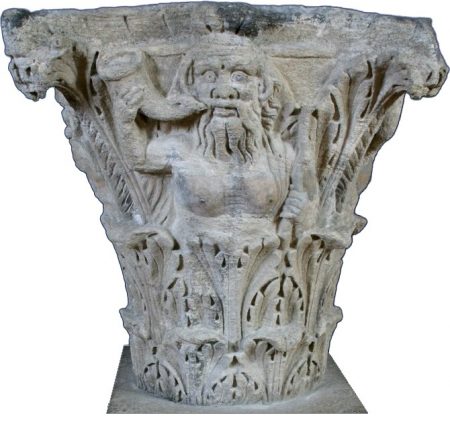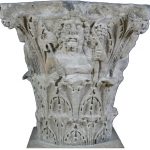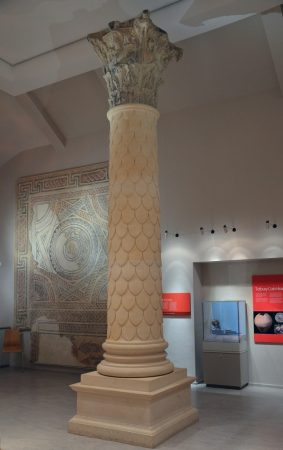Isobel is one of our summer intern placements. She is currently studying at Utrecht University and has an interest in the classical world.



 This Corinthian capital once formed part of a Jupiter column which was supported a structure in the Roman forum of ancient Corinium. A Corinthian capital is a feature of classical Greek architecture, and is an ornately decorated crown of a column, adorned with three rows of carved foliage; this style was adopted by the Romans and adapted for their building programmes across the empire, its use then continuing into the medieval period. This example of a capital from Corinium is decorated on four sides, and the central figure of one side is clearly distinguishable as Bacchus, the Roman god of wine, because of the attribute of bunches of grapes on either side of his head. The other three sides are also decorated with religious and ritualistic images. Besides Bacchus, his foster-father, Silenus, has been carved with a drinking horn pressed to his lips, creating a similar image to the stone depiction of the god of festivities. Next, Lycurgus is depicted with a vine staff in one hand, and a doubled-headed axe in the other; this mythological figure was the king of Thrace, and banned the worship of Dionysos, the Greek god by whose cult Roman worship of Bacchus was influenced. The last side depicts Ambrosia, named for the sustenance of the gods, who was a member of the entourage of Dionysos in Thrace, and who turned herself into a grapevine to escape the wrath of Lycurgus. On the capital, Ambrosia is depicted playing a drum, again invoking celebration and festivity. This capital clearly alludes to a group of myths surrounding Bacchus.
This Corinthian capital once formed part of a Jupiter column which was supported a structure in the Roman forum of ancient Corinium. A Corinthian capital is a feature of classical Greek architecture, and is an ornately decorated crown of a column, adorned with three rows of carved foliage; this style was adopted by the Romans and adapted for their building programmes across the empire, its use then continuing into the medieval period. This example of a capital from Corinium is decorated on four sides, and the central figure of one side is clearly distinguishable as Bacchus, the Roman god of wine, because of the attribute of bunches of grapes on either side of his head. The other three sides are also decorated with religious and ritualistic images. Besides Bacchus, his foster-father, Silenus, has been carved with a drinking horn pressed to his lips, creating a similar image to the stone depiction of the god of festivities. Next, Lycurgus is depicted with a vine staff in one hand, and a doubled-headed axe in the other; this mythological figure was the king of Thrace, and banned the worship of Dionysos, the Greek god by whose cult Roman worship of Bacchus was influenced. The last side depicts Ambrosia, named for the sustenance of the gods, who was a member of the entourage of Dionysos in Thrace, and who turned herself into a grapevine to escape the wrath of Lycurgus. On the capital, Ambrosia is depicted playing a drum, again invoking celebration and festivity. This capital clearly alludes to a group of myths surrounding Bacchus.
Corinium Dobunnorum was invaded by the Romans during the initial conquest of Britannia, and a Roman fort was founded at the site around a year after the conquest begin, approximately 44 CE. This was made possible in part by cooperation from the friendly tribe of the Dobunni, who welcomed and allied themselves with the Romans. This fort was replaced by the development of a town thirty years later in 75 CE, at the location of modern-day Cirencester, and the town was named Corinium. The settlement became the tribal capital of the Dobunni, the Celts loyal to the invading Romans, and developed into a prime example of a Roman provincial city over the next century. Archaeological evidence has revealed that besides the forum where this capital was found, Corinium was a fortified city built according to a street grid and centring around a cattle market, market hall, and shops such as butchers, bakers, goldsmiths, blacksmiths, and glassmakers. Corinium had an impressive system of wooden water pipes, an aqueduct, a partially extant amphitheatre, and several stone houses of the wealthy with impressive mosaic floors. There is so far no evidence of public baths or temples but finds such as this capital demonstrate much religious and cultural activity in the city. Corinium developed into the second-largest city in Roman Britain, after Londinium, and accordingly boasted a large forum and basilica rivalled only by those of the latter. Moreover, the population of Corinium by the second century was around 15,000, remarkably similar to that of Cirencester today.
This Corinthian capital with Bacchus suggests that the architecture of the city was quintessential for the northern European Roman provinces: it was once at the top of a Jupiter column. These kinds of columns are an archaeological occurrence found mostly in the ancient Roman province of Germania, along with examples across those of Gaul and Britannia. Jupiter columns are useful to historians because they reveal the religiosity of the context in which they were produced. No Jupiter columns have been excavated intact, but archaeologists are able to identify how they likely looked from the various partial examples. The base of these columns was normally formed by a stone depicting four gods: Juno, the protector of the state and wife of Jupiter, Minerva, the goddess of arts and strategic warfare, Mercury, the messenger god and ruler of finances and luck, and Hercules, the divine hero notorious for his strength and adventures. This base would support a pillar decorated with a scale pattern, which would be crowned by a statue of Jupiter killing a giant or enthroned. Most Jupiter columns had a height of around four metres, however, there are taller examples across Germania. Jupiter columns were most often used within walled enclosures, beside an altar. Reconstructions of the columns are popular, and the Corinium Museum is no exception – this capital is displayed in the museum atop a replica, scaled column. Overshadowed by this column, and peering up at the four faces of the mythological figures, you can begin to imagine the strikingness of the art and architecture in Roman Corinium, and the long and significant history of Cirencester as a Celtic capital, a Roman stronghold, and a time capsule for modern historians.

References & Further Reading
“Corinthian Capital.” Corinium Museum, coriniummuseum.org/object/a348-2/.
“Jupiter Column with Rare Relief Found in Roman Well in Germany.” The Archaeology News Network, 20 Aug. 2020, archaeologynewsnetwork.blogspot.com/2020/08/jupiter-column-with-rare-relief-found.html.
“Mainz, Jupiter Column.” Livius, www.livius.org/articles/place/mogontiacum-mainz/mogontiacum-mainz-photos/mainz-jupiter-column/.
“RIB 103. Dedication to Jupiter Optimus Maximus.” RIB 103. Dedication to Jupiter Optimus Maximus | Roman Inscriptions of Britain, romaninscriptionsofbritain.org/inscriptions/103.
“The History Blog.” The History Blog RSS, www.thehistoryblog.com/archives/59325.
“The Roman Sculpture of Corinium – Corinium Museum – Google Arts & Culture.” Google, Google, artsandculture.google.com/exhibit/the-roman-sculpture-of-corinium-corinium-museum/hgIyQj9yQ4QkLA?hl=en.










